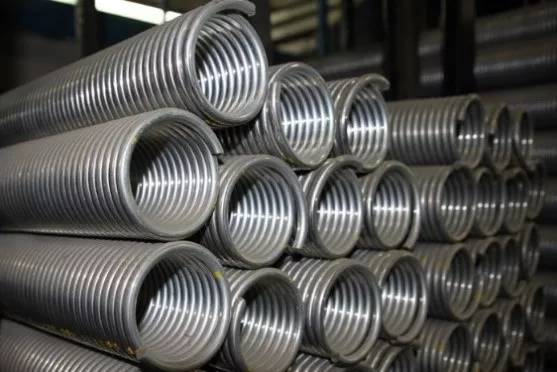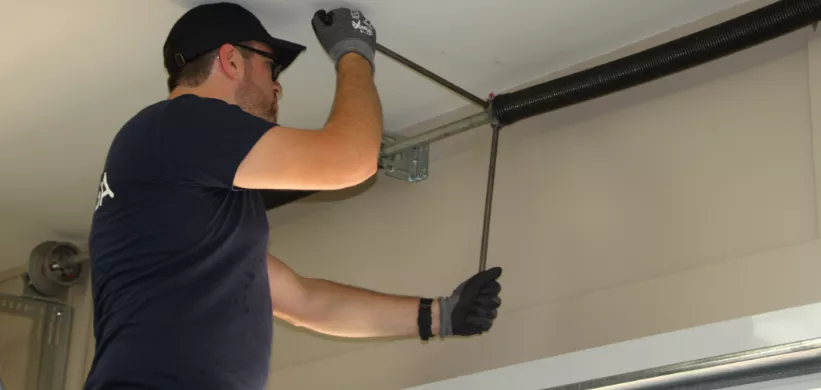Have you ever wondered about your garage door springs and how they work? This doesn’t usually come to mind for a lot of people, but if your springs break or malfunction, you might find yourself wanting to know more about the system.
Every garage door is installed with a spring system that is designed to counterbalance the heft of the door. The average garage door weighs 200‑300 pounds, but when the system is properly balanced, it feels like it only weighs eight or 10 pounds and is easy to operate manually as well as with the electric opener. As such, this system is a lot more important to the entire garage door than you might realize, so take the time to find out a little more.

Springs 101: Get the basics down
Every sectional overhead door is going to be outfitted with springs. There are two different spring systems available, known as torsion springs and extension springs. If you can’t tell, take a look at your garage:
- If there is a giant spring inside of a steel shaft at the front wall above the door, you have a torsion spring system.
- If there are two springs located on the horizontal tracks overhead, you have an extension spring system.
Torsion springs are the most commonly found in residential garages. This is because, generally speaking, they are quieter, safer, and offer a more efficient operation than extension springs.
- Quiet: These springs are attached over the door, rather than being suspended or attached to the track itself. Therefore, there is little noise transmission during door operation.
- Safe: Torsion springs are put inside of a shaft to help keep them stable and safe. That means if the spring breaks, the shaft will still be attached to the door. In the case of extension springs, they could snap, fly into the wall or car windshield, and cause a lot of damage.
- Efficient: With torsion springs, the weight of the door is transferred fully to the anchor plate, which is at the center of the door. This allows for much more efficient operation. Springs over the horizontal tracks often cause shaking or excessive noise, and may work harder because the weight has to be balanced between two springs instead of just one.
So, how do they work?
Torsion springs aren’t only found in garage doors. Once you understand how they work, you’ll see how they could have a variety of applications.
This spring is shaped like a giant coil. Think of it kind of like a screw‑every time the spring twists or torques, it stores mechanical energy as it goes. This is what provides the counterbalance and makes the garage door seem much lighter than it actually is. It’s also why your door should be easy to lift by hand when it is properly balanced.
It’s a team effort
Torsion springs don’t work alone. The spring system itself includes a shaft, an anchor plate for mounting, and a drum and safety cable system that are all connected to offer a safe, properly balanced, functioning garage door. In order for the door to work as it should, everything has to come together:
Brackets + Lift Cables + Drum + Spring + Shaft
When the door is open, the spring system is relaxed. Once you close the door, the energy transfers into the torsion spring system.
So, how much does a garage door weigh? We already mentioned they average hundreds of pounds, but here are some more specific numbers for you:
| 1 ¾” steel door with insulation | |
| 9’ x 7’ single door | 150‑160 lbs. (68‑73 kg) |
| 16’ x 7’ double door | 280‑295 lbs. (127‑135 kg) |
| 2” steel door - no insulation | |
| 9’ x 7’ single door | 125‑130 lbs. (57‑59 kg) |
| 16’ x 7’ double door | 280‑295 lbs. (102‑107 kg) |
Keep in mind, of course, that if you choose a solid wood door, it could weigh up to 350 pounds or more.
Garage Door Springs Q&A
Here are some of the most common questions about garage door springs to help you better understand your garage door system.
-
If there is only one spring, is it always on the left of the door?
Not necessarily. Garage door companies make springs for the left side of the door and the right side. If there is only one spring required, it doesn’t matter which side it is on.
-
Do I need one spring or two?
Smaller single garage doors (9 feet) will generally be fine with a single spring to balance the door. Double doors (16 feet) should have dual springs for the best operation.
-
How long will a spring last?
Most garage door springs are rated for up to 10,000 cycles. A single cycle refers to opening and closing the door one time. If you use your garage door two or three times per day, a spring should last for about seven years. Of course, the torsion spring will lose some power over time. If you use your door more than three times a day, you might want to invest in a higher‑end spring that will provide up to 25,000 cycles of use
-
Are they made of galvanized steel?
All torsion springs are galvanized, to some extent. The average spring has about 35‑40% galvanization, which is done by adding zinc to the metal. If you live in a humid or damp climate, you might want to invest in a higher grade fully‑galvanized garage door spring.
-
How can I extend the life of my garage door springs?
The best way to protect your garage door springs, and most of its other working parts, is proper lubrication. This not only prevents corrosion, but it reduces noise and extends the longevity of the spring system itself.
-
How do I know if they’re working correctly?
If you have an electric garage door opener, you can test the spring balance by releasing the emergency cord. Then, lift the door manually to ensure that it goes up evenly and feels lightweight when you lift it. Use a single hand to make sure the door is doing its job.
-
Are torsion springs always at the front of the garage?
Not necessarily. There are some situations where there isn’t going to be enough room between the ceiling and the track or opener. In this case, the torsion spring can be mounted at the rear of the door. This installation will also require double horizontal tracks.
Leave broken springs to the pros
You’ve probably heard it before, but you should never attempt to repair or replace your own garage door springs. These are highly pressurized springs that require the use of special tools and they can be very dangerous to work with.
If you are located in St. Catharines or Niagara Falls area, we’re here to help. Our expert technicians can take care of all of your garage door springs, including assisting with spring repairs and replacements. Plus, we’ll send your quote via email for your convenience and privacy. Or, you can reach us at 1‑800‑263‑4972.









Add new comment